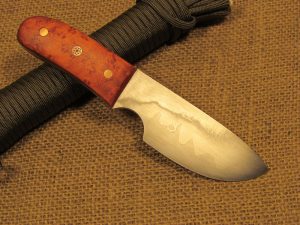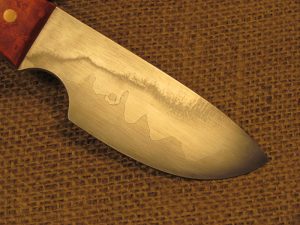In the past, we covered forge welding as it relates to Damascus steel here. But forge welding can be used to stick hot steel together in lots of different ways. San Mai is a Japanese technique now in widespread use in Japanese style and non-Japanese style knives. It translates to “three layers.”
Gimme the Steel Sammich, Extra Flux, Hold the Fries
San Mai steel is three layers forge welded together. The two outer layers are of the same type and often referred to as the jacket (bread) and the middle layer is referred to as the core (meat). Like Damascus steel, I make San Mai by MIG welding the layers together at the corners (this layered bar is called a billet) and welding a steel bar to the billet for ease of handling without tongs during the forging and forge welding process. Unlike Damascus, San Mai is not folded.
 And Make It HOT!
And Make It HOT!
First, I forge weld the billet as described in the aforementioned Real Steel: The Mystery of Steel—Myth and Fact of Forge Folding. I don’t do any forging to shape after the billet is welded together, because forging will distort the layers more than is desirable.
Uhhh, Make It a Grinder!
The rest of the shaping is done on a 2×72” belt grinder; the profile first, then the bevels. Grinding the bevels is what “peels back” the jacket and reveals the core, creating the wave pattern, which is then enhanced by etching. The etch will affect different types of steel differently, so there is contrast between the core and jacket.
Why San Mai?
The technique was used in ancient Japan to create blades that have lower carbon (tougher) jackets and higher carbon (harder) cores. This spared the rare, higher carbon steel for the cutting edge, and created a tough, harder-to-break jacket to protect it. Today the technique is used for aesthetics—and I really like how it looks.

A Little EDC
The knife in the accompanying pics is a little San Mai EDC (every day carry) I’m just finishing up. It has a 1080 jacket over a 1095 core; the carbon difference is just enough for a subtle contrast. More commonly, a high nickel steel, like 15n20, is used over a high carbon steel core, and the 15n20 resists the etch almost completely, leaving a bright steel / almost black steel contrast. This knife also has a hamon, which we talked about here. The high nickel content won’t allow 15n20 to form a hamon, which is one of the reasons why I chose 1080 for the jacket. The handle is birds eye maple, the center pin is mosaic tube, and the two outer pins are bronze.


Pretty! A nice utility knife. (I’m assuming EDC doesn’t mean a personal defense weapon.)
…but how much damage does it do?
All jokes aside, the aesthetic wave effect is amazing. I’m definitely jealous!
@Thorr-kan – Every Day Carry usually means utility. But if it’s got a practical, easy to carry design, an EDC could be a defensive knife. This is a utility, but it’s a good shape for a skinner also.
@RocksFallBlog – Hehe, thanks.
I’d say it’s your standard knife so it will do 1d3 damage
@Todd Is the ‘meat’ part of the blade smaller than the two ‘bread’ jackets? Or do you just grind away all the ‘bread’ parts?
@Darkjoy – I like the core to be *at least* as thick as the jacket, and a tad thicker is better. In general, if the jacket is too thick the border forms too close to the edge, and if it’s too thin the border forms to close to the spine. If the core is too thin it can be difficult to keep the edge centered in the finished blade. It’s actually easier to do than it sounds. :)
That blade looks great, Todd. I love seeing your pieces….and I especially love using the chef knife you made me. :)
@Adam Daigle – Thanks Adam. Good to hear you’re diggin’ the chef knife.
You settling in the new place?
Yep! Today marks my 1-week anniversary and things are going well.
San mai is chinese, not japanese. The technique began in China and was copied all over the orient. The Japanese did take the method to new heights, first with the odachi and later with the katana. Many katanas have five different steels in them, some even more. But I just want to point out how the ancient Chinese smiths have not been given their due. There are swords in museums that qualify for art pieces from ancient china that have seen wars, especially the really ancient bronze weapons. Some of their work was absolutely stunning. Give the Chinese forebears of Japanese smithing their due.